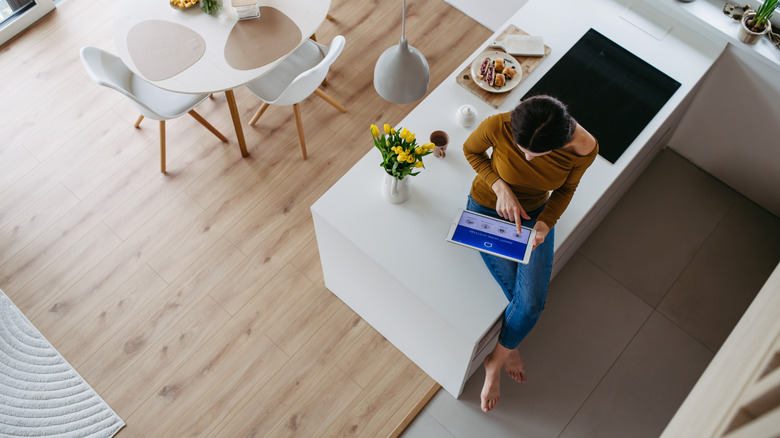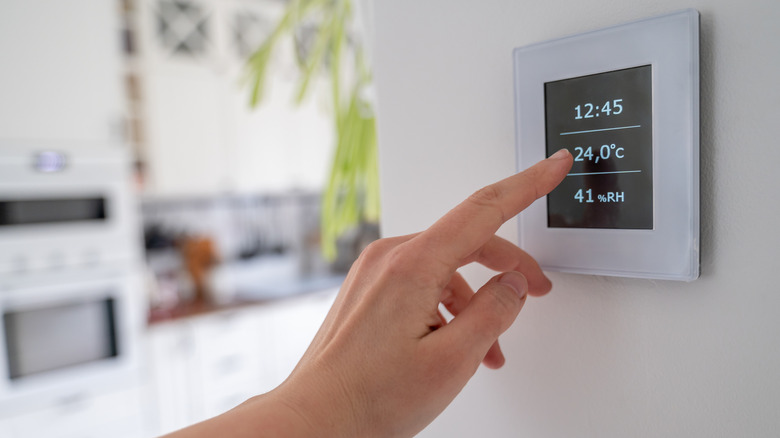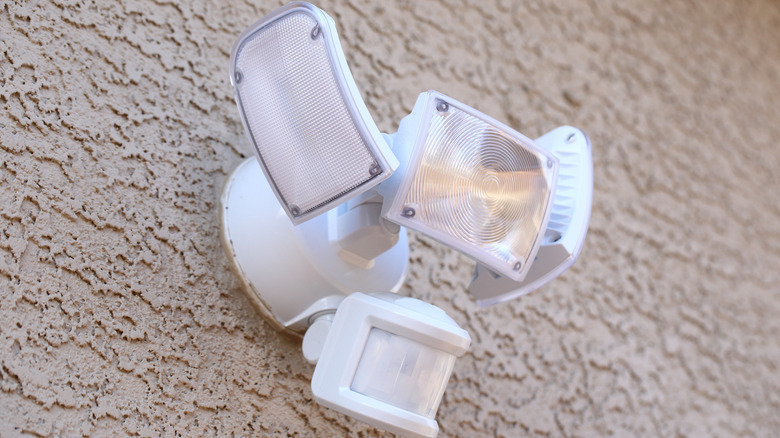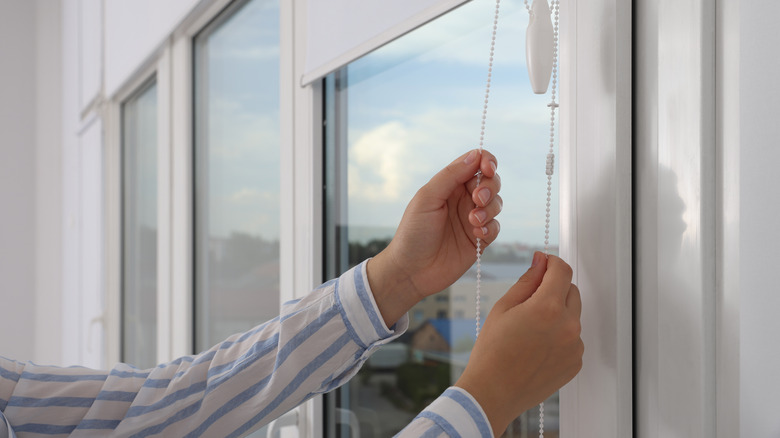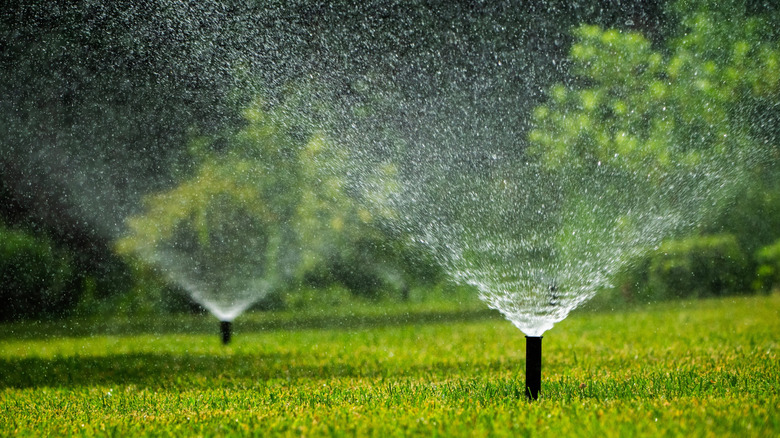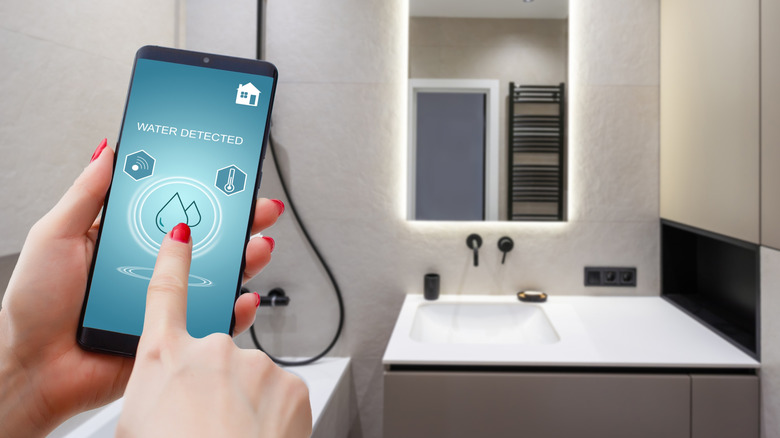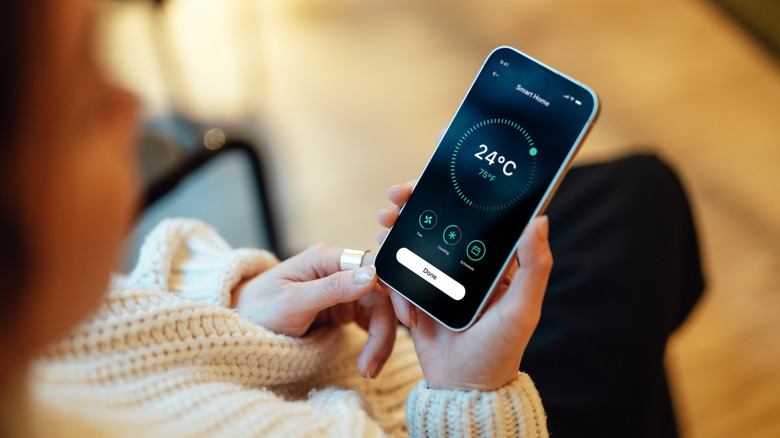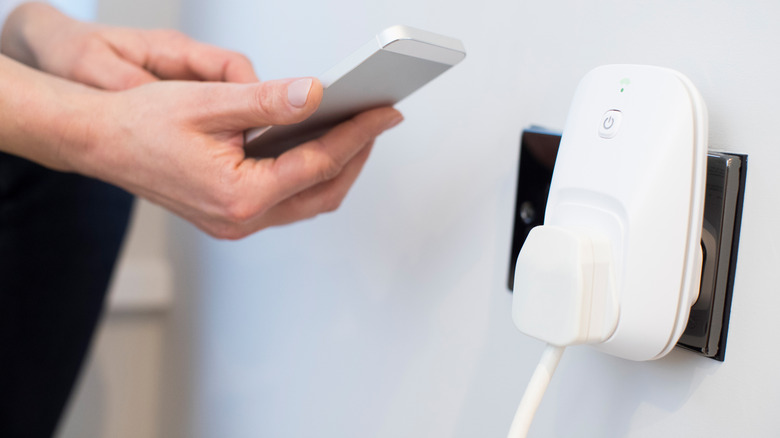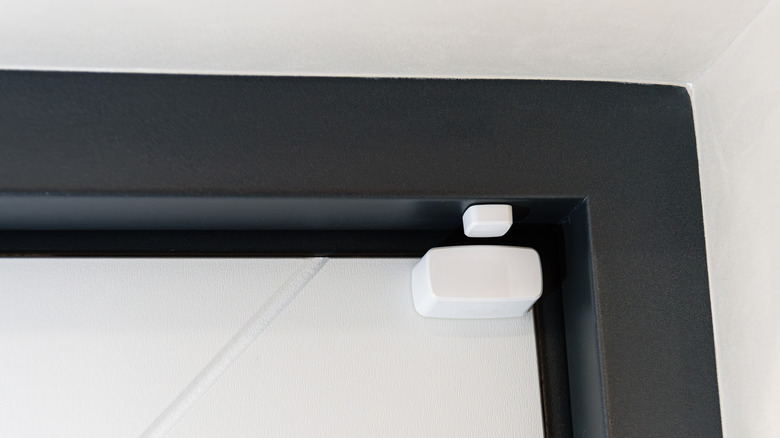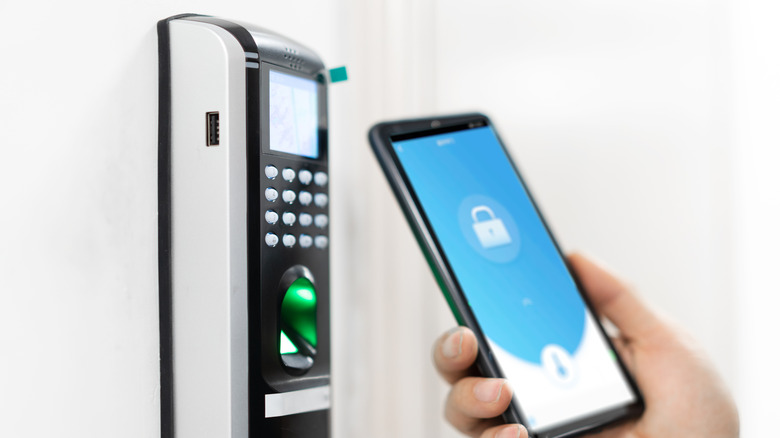10 Smart Home Automations That Will Help You Save Money
Smart home automations have been touted as a way to save money. But exactly how does spending money on technology keep more dollars in your pocket? You're trying to cut costs, or are at least intrigued by the idea. So when you're shelling out hundreds or even thousands of dollars for smart home gadgets, hubs, lighting, and appliances, it's fair to wonder how much of your investment you'll recoup.
Here's the thing: Smart home automation doesn't have to cost a lot of money. And when you use smart home automation strategically, you're not just enjoying a little convenience and novelty — you're also gaining control over your daily life. You can manage certain aspects of your home remotely, which comes in handy when you forget to turn down the thermostat, or worse, when disaster strikes in the form of a water leak. The savings aren't always mind-blowing, but quietly lowering your expenses by a few dollars (or more) a month can add up. Plus, you can feel good about making your home work harder for your wallet. Here are 10 smart home automations that will help you save money.
Use a smart thermostat to automatically adjust heating and cooling
Smart thermostats connect to your HVAC system and your home's Wi-Fi. They're a step up from programmable thermostats, which let you set specific heating and cooling schedules. Smart thermostats do this too, but they also give you the option to control your thermostat remotely via your smartphone. Since they're Wi-Fi-connected, you can use the thermostat's app to change settings when you're away. These apps are usually intuitive, allowing you to customize or edit schedules and settings in just a few seconds. They also give you access to data analytics so you can compare your energy usage month by month, spot patterns, and find more ways to lower your energy bill.
For example, you can set up different schedules for every day of the week. Lower your thermostat in the winter or raise the temperature in the summer during working hours, then schedule a more comfortable setting to start before you arrive home so you can walk into the perfect environment. Some smart thermostats use machine learning to optimize these schedules over time, making the process less hands-on for you while still helping you save on energy costs. And if your plans change (like you're working late or taking an extra day of vacation), you can open the app to make quick changes that extend your savings even more. It's estimated that a smart thermostat can save you up to 8% in energy costs, or about $50 per year.
Try motion-sensing lights in low-traffic areas
Have you ever forgotten to turn off the closet light? Or the light in the attic? No one wants to pay to light rooms they're not using, but things happen. For low-traffic areas, motion-sensing lights may provide a better option. These hands-free lights automatically turn on when they sense motion in the area. After a period of inactivity, the lights will automatically turn off. It's a seemingly small move that could have a noticeable impact on your energy bill if you constantly forget to turn off lights.
They're best in places where people aren't spending a lot of time at once and only need lighting for a short period, like closets, hallways, pantries, and the laundry room. Granted, leaving a light on accidentally won't break the bank. But over time, these habits can turn into more than the occasional accident. This means wasted energy, higher utility bills, and more frequent lightbulb replacements. Using lights only when necessary helps you get the most out of every bulb. Smart motion-sensing lights let you specify timeouts (e.g., lights turn off after 2, 5, or 15 minutes of inactivity), adjust the sensitivity so pets won't trigger them, customize them for day or night use, and adjust the lighting brightness and color. Savings can vary depending on your track record of forgetting to turn off lights, but you can expect to save up to 70% in energy in the places where you install motion sensor lighting.
Sync your home's lighting with natural light
Natural lighting costs nothing and can fill your home with all the light you need. If you already have smart lighting in your home (or want to find ways to implement it), you can sync it to follow the sun's schedule. Unlike fixed-time schedules, where your smart lights turn on and off at specific times each day, sunrise and sunset automation adapts to each day based on where you live. The sun rises and sets at different times each day, so your smart lighting can follow a similar schedule to provide lighting only when it's truly needed.
For example, you might have your porch lights turn on at sunset and turn off at sunrise. Syncing your smart lighting with natural light means these lights won't turn on too early or stay on too late. You'll never have to reprogram schedules because of daylight saving time. The process is truly hands-free. This also applies to indoor lighting, like gradually lighting your kitchen at sunrise to ease you into the day. It supports your natural circadian rhythm, which may help you sleep better and feel more rested when you wake. In terms of saving money, you won't be leaving lights on longer than needed, which will help you cut down on energy costs. It can also make your house look "lived in" while you're away, like having a cheap security system and saving you hundreds of dollars compared to a traditional one.
Invest in smart irrigation to avoid overwatering
A luscious lawn requires water, and plenty of it. Traditional sprinkler systems let you program schedules to help your lawn get enough water. The problem is that they operate regardless of the weather or your soil's moisture level. If it's raining and your sprinkler system is scheduled to kick in, your lawn will get more water than it needs — at your expense. A better option is to use a smart irrigation system that monitors the current weather and soil moisture. This way, it knows how much water your yard needs, if any.
Smart irrigation systems connect to your Wi-Fi and use real-time weather data. If it's going to rain in the near future, it might not water your lawn as much. On hotter days, it might water the lawn a little more than usual. And if it's currently raining or your lawn just got a good drenching, it will hold off on watering. Some systems even break up watering into shorter intervals to let more water absorb into the soil and prevent runoff. You can monitor and control your smart irrigation system via an app. So even if you're at work or on vacation, you can ensure your lawn is getting the TLC it needs. In terms of savings, you're reducing water and electricity use, and helping avoid potential yard problems associated with overwatering, like mold, erosion, damage to plants and flowers, soil compaction, and loss of nutrients in the soil.
Set up water leak detection alerts and automatic shutoff
Water damage is among the most expensive types of damage in a home. It can cost thousands of dollars to fix, plus it's messy and time-consuming to clean up. Many leaks start small and may go unnoticed for days or weeks, especially in places like under sinks, behind appliances, or near your water heater. You're paying for all that water leaking from your pipes, not to mention what it costs to repair flooring, baseboards, drywall, and anything else in the leak's path. A smart water leak detection system can curb these losses, acting as an early warning system before leaks become expensive problems.
These devices use sensors to detect water in places it shouldn't be. They may monitor for moisture, changes in temperature, or the presence of water in areas like under washing machines or around toilets. A rise in humidity or direct contact with water may trigger an alert. Some sensors also monitor the water flow in your pipes. They learn your usage patterns and alert you when something changes. Smart alarms may sound an alert, or send a notification to your mobile device so you can take quick action. In many cases, smart sensors will automatically shut off the water flow until you're able to address the issue. The sooner you know about a leak, the sooner you can prevent costly damage.
Create heating and cooling zones in your home
Most people aren't using every room in the house at the same time. Naturally, we use some rooms more than others and for longer periods. Yet standard thermostats force us to heat and cool each space equally. It's expensive to heat and cool a home, especially if you're conditioning rooms you're not even using. That's why zoning can be such an effective cost saver. Smart thermostats allow you to create "zones" in your home. Instead of heating or cooling your entire house to the same temperature, you can choose different temperatures for each zone. It's kind of like having a separate HVAC system for each area or room, but much more efficient.
You can set up zones based on how often you use certain rooms and when you use them. For example, you might spend more time in your living room and kitchen during the day than your bedrooms, so these can be separate zones. Smart thermostats take the guesswork out of setting up zones by monitoring occupancy and temperature in different rooms. Sensors tell the thermostat where you are in the house and automatically adjust heating or cooling. As for savings, it varies by thermostat, the size of your home, local climate, occupancy, and other factors. In general, an Energy Star-rated smart thermostat can save up to 8% on heating and cooling.
Use smart plug schedules to minimize energy consumption
When you plug something into an outlet, it starts drawing power immediately, even if you're not using that item (and even if it's turned off). It's called "vampire energy." Just think about the many items you have plugged into a power outlet at any given time — printers, chargers, coffee makers, toasters, video game consoles, and more. One way to minimize this energy waste is to trade your typical power outlets for smart plugs. These offer an affordable and easy way to bring smart home automation to any non-smart device. By plugging a gadget or appliance into a smart outlet, you instantly gain a way to control that item from your phone.
Smart plugs allow you to set automated on/off schedules for anything you plug into them. For example, you can program a coffee maker to turn on just before you wake up and turn off after you've left for work. There's no need to power it all day, plus you gain peace of mind that it's off. Use them for other daily go-to's in your home that you don't use all day, like the television, side table lamps, or your Alexa device. You can change the schedule for your plugs via your smartphone. Some plugs even show you which devices are using the most power and other data. You can stop giving a portion of your paycheck to vampire energy and keep a little more cash in your pocket.
Integrate window sensors to automatically turn off your HVAC system
It's no secret that insulated windows are one way to make your home more energy efficient. But that's not the only way windows can save you money. When you open a window to air out your home or get rid of smoke or bad smells, all that conditioned air (and your hard-earned cash) goes with it. If your HVAC is running while your windows are open, it's working overtime to heat or cool the house while all that air escapes. One way to overcome this (and save some cash) is to install window sensors that work in tandem with your HVAC system. These sensors connect to your windows and tell your furnace or air conditioner not to run when a window is open.
Window sensors are most useful in the spring and fall when it's tempting to open a window for ventilation but forget the AC is still on. They're also helpful if you have kids at home who might open windows in their bedrooms or play areas without thinking about the consequences. Even if you already have a smart thermostat and programmed schedules or zones, the sensors can override any schedules and tell your thermostat when it's safe to resume. This helps you avoid wasting energy and can extend the life of your HVAC system since it's not working to heat or cool the house and the rest of the neighborhood.
Save money on home insurance with smart security systems
Saving money with smart home automations doesn't just affect your energy bills. It can also reduce another important bill — your homeowner's insurance. The more secure your home is, the lower the risk that your insurance company will need to pay out a claim. Many insurers offer discounts to homeowners who have installed security systems, with savings of up to 15% on your total premium. Even better if it's a smart security system, since these systems can detect issues faster and provide detailed records when something goes wrong.
Components of a smart security system include, but are not limited to, smart doorbell cameras, smart door locks, motion sensors, glass break detectors, and smart smoke and carbon monoxide detectors. These devices connect to your home's internet and can be managed remotely via smartphone apps. For example, if someone breaks into your home through a window that has sensors installed, you'll get an alert that your device detected a break-in, allowing you to take quick action. Doorbell cameras track who's coming and going from your home, while smart locks keep track of who is accessing your house. You can build a complete smart security system or install a couple of devices, whatever your budget allows. Savings will vary by insurance company and the type of security you invest in.
Enable vacation mode automation
When you leave for an extended absence, like a vacation or work trip, you probably have a checklist of things to do before you go: unplug the toaster, turn off all the lights, adjust the thermostat, activate the security system, things like that. Or, if you're using smart home automation, you can set your home to "vacation mode" and leave the rest to technology. Vacation mode saves energy while you're not at home. It keeps your home comfortable and can make it look lived in, but it significantly reduces energy demands so you can save money while you're away.
Vacation mode triggers a series of actions across your smart home connected devices. These steps can vary depending on your setup, but in general, they cover things like auto-adjusting your thermostat (lower in the winter or higher in the summer), randomizing lighting to make it look like you're home, reducing how much your water heater runs, shutting off appliances or other electronics completely, and arming your smart security system. The best part is that vacation mode is usually a one-step action. With the tap of a button or a voice command, you can start saving money throughout your home without a second thought.
